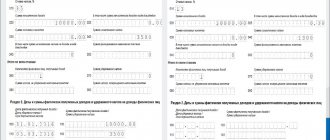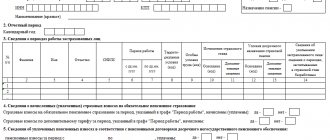It is the responsibility of all employers who are policyholders to fill out and submit the DAM form to government agencies. The document has a certain structure. You must enter information into the form taking into account a number of rules. Many employers have a number of questions when filling out the form. For example, not everyone knows whether dismissed employees should be displayed in the DAM. To answer this question, you need to refer to the current regulatory documents governing this area.
Dismissed employees are included in the DAM
Section 3 of the DAM is filled out by the payer for all insured persons in whose favor payments and other remunerations were accrued during the reporting period, including those dismissed in the previous reporting period. Such explanations are given by the Federal Tax Service in a letter. At the same time, the attribute of the insured person is indicated, including for dismissed persons, “1” - is the insured person and the corresponding category code of the insured person, for example “NR”. If the personalized information about the insured persons does not contain data on the amount of payments and other remuneration accrued in favor of an individual over the last three months of the reporting (calculation) period, subsection 3.2 of section 3 of the calculation is not completed.
Consequently, for insured persons who have not received payments or other remuneration for the last three months of the reporting (calculation) period, the payer fills out section 3 of the calculation, with the exception of subsection 3.2.
How to fill it out correctly?
The DAM is drawn up in accordance with the form approved by order of the Federal Tax Service of Russia No. ММВ-7-11 / [email protected] dated October 10, 2021. The same document also contains the procedure for filling out the form.
Instructions for entering information into the RSV form:
- The title page must be completed by all policyholders. Information about the employer is indicated (TIN of the organization, KPP (for legal entities), organizational and legal form, OKVED-2, contact phone number), document correction number, reporting period code, calendar year, number of pages of the document. In the second part of the title page, information about the official who signs the form is entered. Indicate full name, personal signature, date of filling out the DAM;
- The first section is completed. This displays information about insurance premiums that the employer calculates from the salaries of his subordinates. The budget classification code is indicated;
- The third section is completed. Personalized information is provided separately for each employee. The employee’s TIN, SNILS, citizenship, gender, date of birth, series and passport number are indicated. A note is made as to whether the subordinate is insured or not. Completing section 3 for resigned employees has some features. Information is not entered into subsection 3.2 if no accruals were made for the reporting period. In this case, only information is provided that allows the identification of employees with whom the employment contract was terminated.
When filling out the document, you should adhere to the following rules:
- number the pages by putting “001”, “002”, “003”, etc. in the corresponding cells;
- text fields should be filled in from left to right in block letters;
- write decimal fractions in two genders;
- At the end of each page put a date and signature.
Calculation of contributions: indicate former employees in section 3 or not
From the clarifications issued by the Ministry of Finance (, ), it is only clear that subsection 3.2 “Information on the amounts of payments and other remuneration calculated in favor of individuals...” for such employees does not need to be filled out.
Which is logical, since since there were no payments, there is nothing to include. But it remains unclear whether such dismissed persons should be indicated in subsection 3.1 “Data about the individual recipient of the income.” Recently, the Federal Tax Service issued an explanation (), which states the following: “... in cases of failure to include in the calculation of insurance premiums for the reporting (calculation) period, employees who resigned in the previous reporting period and who did not receive payments in the reporting (calculation) period must be submitted to the tax authority by place of registration, an updated calculation of insurance premiums for the reporting (calculation) period, indicating in section 3 of the calculation of all insured persons in whose favor payments and other remunerations were accrued in the reporting (calculation) period, including those dismissed in the previous reporting period.” .
Average headcount on the title page
A new attribute was added to the title page - “Average headcount (persons)”. It is determined in the manner established by Rosstat Order No. 711 dated November 27, 2019. According to the same rules, insurers calculated the indicator for o.
Amendments to Part 1 of the Tax Code of the Russian Federation were introduced by Federal Law No. 5-FZ dated January 28, 2020. Clause 3 Art. 80 of the Tax Code of the Russian Federation in the new edition reads as follows: “Information on the average number of employees is submitted to the tax authorities by payers of insurance premiums who make payments and other remuneration to individuals as part of the calculation of insurance premiums.” According to the rules of the old edition, policyholders submitted information for the previous calendar year in a separate report and did this once a year - no later than January 20 of the current year.
Also, to the list of information that tax authorities have the right to require from payers of insurance premiums, they added “information on the average number of employees to be included in the DAM” (clause 7, clause 7, article 80 of the Tax Code of the Russian Federation).
The provisions in the new edition apply to legal relations related to the presentation of the DAM, starting with the calculation based on the results of 2020.
For 2021, you do not need to submit information on the average number of employees until January 20, 2021 using a special form. It is enough to indicate the average number of employees in a specially designated field on the title page of the DAM for the billing period of 2021 and subsequent periods.
Many features have appeared in Externa so that you can fill out the RSV quickly and without errors. Try it, it's free
DAM adjustment for the 1st quarter of 2021
> > > Tax-tax February 13, 2021 All materials for the story will be required if in the original version of this report sent to the Federal Tax Service, the tax authority or the report submitter himself discovers errors in calculations or inaccuracies in information about employees.
Read about how to make and submit a DAM with corrective data without negative consequences in our material. Errors of all kinds may occur in the reporting submitted to the tax authority: from typos that do not interfere with understanding what exactly was meant when writing, to data not taken into account in calculations that affect the total of tax payments due.
We recommend reading: Is the owner’s consent required when registering a child?
Insurance premiums, the calculation process of which is reflected in the DAM report, are also included in the latter category starting from 2021. The extension of the provisions of the Tax Code of the Russian Federation to contributions led to the fact that Art.
Section 3 is included in the DAM, even if it is a “null” and a non-profit organization
Until recently, many accountants, reporting for companies where salaries are not calculated, did not take the SZV-M and SZV-STAZH, and passed the DAM without the 3rd section.
Meanwhile, recently the Pension Fund of the Russian Federation, which was previously quite happy with this state of affairs, at the instigation of the Ministry of Labor, spoke out against it. And the other day the Federal Tax Service also took up the “zeros”.
In the letter “On certain issues related to filling out and submitting the DAM,” the fiscal officials explained how NPOs can fill out calculations that do not include salary accruals and contributions. We'll tell you who the Federal Tax Service wants to see in Section 3 of the RSV. At the beginning of April, the Pension Fund of Russia began to announce the need to submit SZV-M and SZV-STAZH to the sole founder of the company, who is its director, who is not paid a salary.
It is noteworthy that previously some branches of the Pension Fund of Russia not only did not insist on this, but, on the contrary, demanded that accountants cancel SZV-M for the founding director without salary. The vector changed after the release of a letter from the Ministry of Labor, which, in general, did not report anything new.
How to reflect bonuses to dismissed employees in the RSV
Date of publication 10/18/2019
The employee was fired on March 20, 2021, and in August it turned out that he was not fully paid his wages. All necessary additional payments were made on August 19, 2021. Personal income tax was withheld from the payment and transferred to the budget. Is it necessary to subject these amounts to insurance premiums and how to reflect them in the 2-NDFL certificate, 6-NDFL calculation, SZV-M, SZV-STAZH forms and in the calculation of insurance premiums?
When paying wages later than the due date, the employer is obliged to accrue interest in the amount of not less than one hundred and fiftieth of the key rate of the Central Bank of the Russian Federation in effect at that time on the amounts not paid on time, for each day of delay from the next day after the due date for payment until the actual day calculation inclusive (Part 1 of Article 236 of the Labor Code of the Russian Federation). Thus, at the same time as the payment of the delayed amounts, interest on the delay must be paid.
Form 6-NDFL and the procedure for filling it out were approved by the Federal Tax Service of Russia by order dated October 14, 2015 No. ММВ-7-11/ [email protected]
At the same time, in accordance with clause 4.2 of Appendix No. 2 to the order of the Federal Tax Service of Russia dated October 14, 2015 No. MMV-7-11 / [email protected] in lines 100-120 the following is indicated:
- on line 100 – the date of actual receipt of income reflected on line 130;
- on line 110 – the date of tax withholding from the amount of income actually received reflected on line 130;
- on line 120 – the date no later than which the tax amount must be transferred.
Lines 100-120 are filled out taking into account the provisions of Articles 223 and 226 of the Tax Code of the Russian Federation.
In accordance with paragraph. 2 p. 2 art. 223 of the Tax Code of the Russian Federation, in the event of termination of employment relations before the end of the calendar month, the date of actual receipt by the taxpayer of income in the form of wages is considered to be the last day of work for which income was accrued to him.
In a letter dated 10/05/2017 No. GD-4-11/ [email protected], the Federal Tax Service of Russia explained that in calculations using Form 6-NDFL, among other things, bonuses paid after dismissal are reflected taking into account the following. The date of actual receipt of income in the form of a monthly bonus paid to the employee after dismissal should be considered the employee’s last day of work. In this case, the procedure for reflecting the monthly bonus and salary in the calculation using Form 6-NDFL is the same, i.e. When paying wages for March in August, section 2 of the 6-NDFL calculation must be filled out as follows:
- on line 100 – 03/20/2019;
- on line 110 – 08/19/2019;
- on line 120 – 08/20/2019.
The form and procedure for filling out the 2-NDFL certificate were approved by order of the Federal Tax Service of Russia dated October 2, 2018 No. ММВ-7-11/ [email protected] , hereinafter referred to as the Procedure.
In accordance with Section V of the Procedure, Section 3 of Form 2-NDFL indicates information on income accrued and actually received by an individual in cash and in kind, as well as in the form of material benefits, by month of the tax period and corresponding deductions.
Income is reflected in section 3, while in the “Month” field, in chronological order, the serial number of the month of the tax period for which the income was accrued and actually received is indicated. Therefore, if the salary is issued for March 2021, it is reflected in the 2-NDFL certificate in the field for March 2021.
Wages paid to an employee (including after his dismissal) are subject to insurance contributions.
In a letter dated March 17, 2017 No. BS-4-11/4859, the Federal Tax Service of Russia indicated the need to reflect in the calculation of insurance premiums information about employees dismissed in the previous period, but to whom payments were accrued in the reporting period. Tax service specialists noted that personalized information about individuals is indicated in section 3 of the calculation. The procedure for filling out the calculation, approved. Order of the Federal Tax Service of Russia dated October 10, 2016 No. ММВ-7-11/ [email protected] (hereinafter referred to as the Procedure), stipulates that this section reflects data on those insured persons in whose favor payments and rewards were accrued in the reporting period (clause 22.1 of the Procedure).
It follows from this that section 3 of the calculation includes information about employees:
- with whom labor or civil law contracts are valid in the last three months of the reporting (settlement) period. The fact of accrual of payments and rewards does not matter. The only peculiarity is that if payments are not made to the employee, subsection 3.2 does not need to be filled out;
- with whom labor or civil law contracts are not valid in the last three months of the reporting (settlement) period, but to whom payments were accrued during this period.
Thus, if a payment was made to a dismissed employee in August, then data about him must be included in the calculation of insurance premiums for 9 months of 2021, despite the fact that he was dismissed in the first quarter of 2021.
The procedure for submitting personalized accounting information is established by Federal Law No. 27-FZ dated April 1, 1996 (hereinafter referred to as Law No. 27-FZ).
According to clause 2.2 of Art. 11 of Law No. 27-FZ, insurers monthly, no later than the 15th day of the month following the reporting period (month), provide information in the SZV-M form about each working insured person (including persons who have entered into civil law contracts, the subject of which is performance of work, provision of services, author's order agreements, agreements on the alienation of the exclusive right to works of science, literature, art, publishing license agreements, license agreements on granting the right to use works of science, literature, art, including agreements on the transfer of powers to manage rights contracted with a rights management organization on a collective basis).
The SZV-M form was approved by Resolution of the Pension Fund Board of February 1, 2016 No. 83p.
Information in the SZV-M form is provided by all insurers in relation to the insured persons working for them, including persons who have entered into civil contracts for which insurance premiums are calculated in accordance with the legislation of the Russian Federation (clause 2.2. Article 11 of Law No. 27 -FZ).
Consequently, for persons with whom an employment contract has been concluded, it is necessary to provide information in the SZV-M form for the entire period of validity of this contract. After the agreement has terminated, there is no need to submit a SZV-M. The last time the SZV-M with employee data had to be submitted for March 2021 no later than April 15, 2021. The payment itself does not affect the obligation to submit SZV-M.
According to paragraph 2 of Art. 11 of Law No. 27-FZ, insurers annually, no later than March 1 of the year following the reporting year (except for cases where other deadlines are provided for by this Federal Law), provide information about each insured person working for them (including persons who have entered into civil law contracts nature, for remuneration for which, in accordance with the legislation of the Russian Federation on taxes and fees, insurance premiums are charged) in the SZV-STAZH form.
The procedure for filling out the SZV-STAZH form is regulated by Pension Fund Resolution No. 507p dated December 6, 2018, hereinafter referred to as Resolution No. 507p.
According to clause 1.5 of Resolution No. 507p, the SZV-STAZH form is filled out and submitted by policyholders for all insured persons working under an employment contract, including heads of organizations who are the only participants (founders), members of organizations, owners of their property or under a civil law contract nature, the subject of which is the performance of work and the provision of services.
In the SZV-STAZH form, the periods of work are indicated in columns 6-7. This information is filled in on the basis of the employer’s documents - this is established in clause 1.3 of the Procedure.
The dates indicated in the “Operation period” column of the table must be within the reporting period specified in section 2 of the form (clause 2.3.2 of the Procedure).
Thus, for 2021, the employee must submit a SZV-STAGE, and in the “period of work” column, fill in the dates of work in 2019, i.e. 01.01.2019 – 20.03.2019.
Don't miss the latest news - subscribe to the site's free newsletter:
- dozens of experts daily monitor changes in legislation and judicial practice;
- mailing is free, regardless of the existence of a 1C:ITS agreement;
- your e-mail is not transferred to third parties;
Personal income tax was withheld from the payment and transferred to the budget.
Peculiarities of taxation of insurance premiums and filling out reports on them.
In accordance with paragraphs. 1 clause 1 art. 420 of the Tax Code of the Russian Federation, the object of taxation of insurance premiums for payers-organizations is recognized as payments and other remuneration in favor of individuals within the framework of labor relations.
From the content of the mentioned norm, as well as the explanations given in the Letter of the Ministry of Labor of the Russian Federation dated 09/02/2013 No. 17-3/1450, it follows that insurance premiums should be charged by the organization for payments and other remunerations made in favor of resigned employees for the period of time in which these employees had an employment relationship with this organization.
To be or not to be fired in section 3 of the calculation of contributions?
→ The article from the magazine “MAIN BOOK” is current as of December 8, 2021.
E.A. Sharonova, leading expert We spoke in
, . The conclusion was this: there are no payments after dismissal - there is no section 3 for former employees.
But from the latest letters from the Ministry of Finance and the Federal Tax Service, one can draw the opposite conclusion. Let us recall that from the Procedure for filling out the calculation of contributions it follows that section 3 must be completed for the last 3 months of the reporting period (in other words, for the last quarter) for all insured persons who in these months payments and other remuneration were accrued. If no payments were accrued to the insured persons in the reporting quarter, then subsection 3.2 of section 3 does not need to be filled out for them.
Is it necessary to hand over a certificate to a dismissed employee?
extract from the RSV form. The obligation to provide the employee with personalized accounting information is established
. A certificate from the DAM is a document confirming the receipt of wages and the accrual of contributions.
Information in the statement is entered only for the employee with whom the employment contract was terminated. The certificate is issued on the day of actual dismissal along with other documents for the employee. According to Article No. 151 of the Civil Code of Russia, a subordinate has the right to file a lawsuit against the employer for refusing to issue the RSV form, as well as to demand financial compensation.
It should be noted that the employer must provide an extract from the DAM to any full-time employee who has applied for such a document. The certificate should be prepared by the accounting department of the enterprise within 5 calendar days after receiving a request from a subordinate.
Filling out the DAM form for dismissed employees
If during the reporting quarter payments were accrued to individuals, including those who were dismissed or those whose employment was terminated in the previous quarter, then information about them is included in section 3 of the calculation of insurance premiums. If during the reporting quarter payments were accrued to individuals, including dismissed or those with whom the employment contract was terminated in the previous quarter, then information about them is included in section 3 of the calculation of insurance premiums. The form of calculation of insurance premiums on the DAM and the procedure for filling it out were approved by order of the Federal Tax Service of Russia dated October 10, 2016 No. ММВ-7-11 / (hereinafter referred to as the Order). The tax period for insurance premiums is a calendar year.
Reporting periods – I quarter, I half of the year, 9 months. The calculation is submitted no later than the 30th day of the month following the billing (reporting) period, taking into account the rule for postponing the date if it coincides with weekends or holidays (clause
We recommend reading: Letter to correct the text in the application
7 tbsp. 431 of the Tax Code of the Russian Federation). Section 3 is intended to reflect the personal data of insured persons in the DAM calculation.
Where and when should I submit the report?
Previously, company managers submitted reports on insurance premiums for full-time employees to extra-budgetary funds, that is, to the Social Insurance Fund and Pension Fund. 2021 has brought some changes. Starting from 2021, the RSV must be submitted to the Federal Tax Service.
It is this organization that monitors the payment of insurance premiums. Employers should send reports to the tax office at their place of registration.
As for the timing, employers must submit the DAM to the Federal Tax Service quarterly by the 30th day of the month following the end of the reporting period, that is, at the end of January, April, July and October.
It should be taken into account that if the 30th falls on a weekend or holiday, then the deadline for submitting the form to the Federal Tax Service is postponed, according to the rules established by the Tax Code, to the next working day.
For late submission of reports
the employer faces a fine
. Its amount depends on whether insurance premiums were paid on time.
Fill out the DAM for the first quarter of 2021 using convenient tools in Externa
April 22, 2021 From January 1, 2021, there were changes in legislation that affected the completion of the calculation of insurance premiums for the first quarter of 2021.
So that you can timely and correctly report to the Federal Tax Service and avoid fines and account blocking, Externa has new features: zero DAM report, quick addition of new employees, convenient filtering and tips on the recommendations of the Federal Tax Service.
— Loading data from SZV-M In the DAM form, section 3 is filled out for each employee, where you must indicate all his details: full name, INN, SNILS, date of birth and gender, as well as the code of the country of citizenship and the code of the type of identification document.
The number of insured persons in section 1 depends on the number of sections 3 with the attribute “insured” in lines 160-180.
Document structure
The RSV form has a certain structure. At first glance, the document seems very voluminous. But the policyholder does not need to fill out all sections.
The document consists of the following parts:
- Title page;
- section No. 1. Summary data on insurance premiums is provided;
- section No. 2. To be completed for heads of peasant farms;
- section No. 3. This is personalized information about each employee.
Sections have subsections and applications.
Dear readers! Our articles talk about typical ways to resolve legal issues, but each case is unique. If you want to find out how to solve your particular problem, please use the online consultant form on the right or call:
7; 8
It's fast and free!
Calculation of insurance premiums for the 1st quarter of 2021: form, example of filling
In 2021, the DAM is represented by all organizations and individual entrepreneurs who pay contributions for their employees without exception to the Federal Tax Service.
In Externa, it became possible not only to update the personal data of employees already in the system, but also to quickly add new employees for the entire reporting period by downloading SZV-M files.
We will tell you which form to use to submit calculations for insurance premiums for the 1st quarter of 2021, and also provide a sample for filling out the report.
All organizations and individual entrepreneurs that transfer payments and rewards to individuals under contracts submit to the tax office a calculation of insurance premiums for the 1st quarter of 2021. The Federal Tax Service has developed an order with changes to the form. Certain calculation indicators will change, and the electronic format will also be clarified.
It was assumed that the DAM for the 1st quarter of 2021 will be submitted in a new form, but the document has not yet been adopted (published on regulation.gov.ru). Obviously, the changes will come into force with the reporting for the 2nd quarter.
Stay tuned for changes. Thus, a new DAM form is not provided for submitting a report
6-NDFL: how to reflect a bonus to a resigned employee?
Form 6-NDFL was approved by order of the Federal Tax Service of Russia dated October 14, 2015 No. ММВ-7-11/ [email protected] Section 2 of the calculation on line 100 reflects the date of actual receipt of income by individuals. This line is filled in taking into account the provisions of Art. 223 of the Tax Code of the Russian Federation (see, for example, letters of the Federal Tax Service of Russia dated November 13, 2015 No. BS-4-11/19829, dated February 12, 2016 No. BS-3-11 / [email protected] ). Therefore, in order to understand the question of how to fill out section 2 of the calculation, let us turn to the specified norm of the Code.
When receiving income in cash, the date of actual receipt by an individual of income is defined as the day the income is paid, including the transfer of income to his bank accounts or, on his behalf, to the accounts of third parties (subclause 1, clause 1, article 223 of the Tax Code of the Russian Federation). In this case, the date of actual receipt of income in the form of wages is recognized as the last day of the month for which the individual was accrued income for work duties performed in accordance with the employment contract. This procedure is established in paragraph 2 of Art. 223 Tax Code of the Russian Federation. The same norm of the Code specifies that in the event of termination of an employment relationship before the end of the calendar month, the date of actual receipt by the employee of income in the form of wages is considered to be the last day of work for which the income was accrued to him.
Let's start with monthly bonuses. The Federal Tax Service of Russia, in a letter dated January 24, 2017 No. BS-4-11/ [email protected] , indicated that the date of actual receipt of the employee’s income in the form of a bonus for performing labor duties based on the results of work for the month, taking into account the provisions of clause 2 of Art. 223 of the Tax Code of the Russian Federation recognizes the last day of the month for which the employee was accrued the specified income.
In our opinion, this position can also be applied when paying a monthly bonus to a dismissed employee. Thus, the date of actual receipt of income in the form of a bonus based on the results of work for the month will be the last day of work of the employee in the organization. Note that the legality of using this approach is confirmed by the example of filling out section 2 of the calculation in form 6-NDFL, which the tax authorities provided in a letter dated 10/05/2017 No. GD-4-11/ [email protected]
As for one-time, quarterly or annual bonuses for achieved production results, stipulated by the employment contract, which are paid to former employees after dismissal, the date of actual receipt of income in this case will be the day of payment of the specified income to the individual, including transfer to his bank account. Specialists of the Federal Tax Service of Russia came to this conclusion in the mentioned letter dated 10/05/2017 No. GD-4-11/ [email protected]
It should be noted that the tax authorities in their response referred to letters from the Ministry of Finance of Russia dated April 4, 2017 No. 03-04-07/19708 and dated September 29, 2017 No. 03-04-07/63400. In the first letter, the financiers indicated that the date of actual receipt of income in the form of other bonuses that do not relate to wages in accordance with the Labor Code should be determined according to the rules of paragraph 1 of Art. 223 of the Tax Code of the Russian Federation on the day of payment of income to an individual. And in the second letter they clarified that Art. 223 of the Tax Code of the Russian Federation does not contain provisions allowing the date of receipt of income in the form of a bonus to be determined as the last day of the month on which the order to pay bonuses to employees is dated. Therefore, in the case of accrual and payment of bonuses (annual, one-time) to employees of an organization, the date of actual receipt of income is determined as the day of payment of income.
In a letter dated 10/05/2017 No. ГД-4-11/ [email protected], tax service specialists gave examples of filling out section 2 of the calculation in Form 6-NDFL for two situations - payment of monthly and annual bonuses to a dismissed employee.
The employee’s dismissal date is August 15, 2021. Under the terms of the employment contract, he is entitled to a bonus based on the results of his work for the month. Due to the specifics of determining this indicator, at the time of dismissal, the company was unable to calculate and pay the employee the amount of bonus due. Based on the order dated August 31, 2017, the employee was awarded a bonus based on the results of work for August 2021 after his dismissal. The bonus was paid on September 8, 2017.
When filling out the calculation for the nine months of 2021, this premium is reflected in section 2 as follows:
— line 100 “Date of actual receipt of income” indicates the last day of the employee’s work in the organization, that is, 08/14/2017;
— on line 110 “Tax withholding date” — 09/08/2017;
- according to line 120 “Deadline for tax transfer” - 09.11.2017, since the day following the day of payment of income falls on Saturday, therefore the deadline according to clause 7 of Art. 6.1 of the Tax Code of the Russian Federation is shifted to the next working day;
— in lines 130 “Amount of actual receipt of income” and 140 “Amount of withheld tax” the corresponding amounts are entered.
An employee of the organization wrote a letter of resignation effective January 15, 2017. The employment contract stipulates that the company must pay him a bonus based on the results of work for the previous year. The calculation and payment of such a bonus are made only after the organization has summed up its activities for the year. The order for payment of the bonus for 2021 is dated February 25, 2021, and the bonus itself was paid on February 27, 2021.
When filling out the calculation for the first quarter of 2021, the annual bonus paid to the dismissed employee will be shown in section 2 as follows:
- line 100 “Date of actual receipt of income” indicates the day of payment of the bonus - 02/27/2017;
— on line 110 “Tax withholding date” — 02/27/2017;
— on line 120 “Tax payment deadline” — 02/28/2017;
— in lines 130 “Amount of actual receipt of income” and 140 “Amount of withheld tax” the corresponding amounts are entered.
The annual bonus paid to the dismissed employee will be shown in section 2 as follows.
Bonus for a deceased employee
Special case - an employee died. What does labor legislation say about the payment of the due bonus?
Again, you will have to divide bonuses depending on whether they are included in wages or are an incentive. Bonuses of the first type, as well as wages unpaid by the day of death of the employee, fall under Article 141 of the Labor Code of the Russian Federation. These payments must be made to his family members or dependents upon their application. A bonus due to a deceased employee based on the results of his work and accrued after his death can also be transferred to relatives.
As for incentives, the issue of their payment is regulated by the agreement and internal regulations . In order for the employer to have grounds to pay the bonus of a deceased employee to his relatives, it is enough to state in the Regulations on Bonuses that this incentive is also due to those employees with whom the employment contract was terminated at the time of accrual. Indeed, according to Article 83 of the Labor Code of the Russian Federation, death is an unconditional basis for termination of the contract.
This is the point of view of officials in the letter of the FSS of the Russian Federation dated 14.
Insurance premiums must be charged for payments to deceased employees.
Federal Tax Service specialists recalled that, according to the provisions of Article 141 of the Labor Code of the Russian Federation, wages not received by the day of the employee’s death are issued to members of his family or to a person who was dependent on the deceased on the day of his death. Moreover, such amounts of payments were actually accrued before the date of death of the employee, that is, during the period when he was an employee of an organization or individual entrepreneur and an insured person under compulsory social insurance. Such payments are subject to insurance premiums, since the provisions of Article 420 of the Tax Code of the Russian Federation determine that the object of taxation of insurance premiums for payers of insurance premiums - organizations are payments and other remuneration in favor of individuals subject to compulsory social insurance in accordance with federal laws on specific types of compulsory social insurance. insurance, in particular within the framework of labor relations.
What's happened.
The procedure for recording unpaid leave in SZV-STAZH
You can fill out the information online and submit it via the Internet in the BukhSoft program. It transmits any reporting online automatically. You can send declarations and calculations to the tax service, social services. fear, Pension Fund, Rosstat and other government agencies. Before sending, any report is tested by all verification programs of the Federal Tax Service and the Pension Fund of Russia. Try it for free:
Several contracts have been concluded for some of them. How many times will such an employee be included in the register: by the number of contracts? No, you need to create one form per employee, but when filling out information about the length of service, it indicates the periods of validity of contracts with their validity dates. Please note that validity dates are reflected only within the reporting period; in reporting for the 2nd quarter, dates must be no earlier than April 1 and no later than June 30. If, after successfully submitting reports for the 1st quarter of the year, there is a need to make clarifications in the report in connection with the additional accrual of bonuses for March for individual employees, do they need to be shown in the report line for the 2nd quarter?
They are indicated in the nominative case.
How to fill out section 3 of the RSV form for dismissed employees?
Unified calculation of insurance premiums Expand the list of categories Subscribe to a special free weekly newsletter to keep abreast of all changes in accounting: Join us on social media.
networks: VAT, insurance premiums, simplified tax system 6%, simplified tax system 15%, UTII, personal income tax, penalties We send letters with the main discussions of the week > > > Tax-tax January 07, 2021 DAM for dismissed employees regarding personal information must be filled out until the current one ends billing period. However, entering data on them in those reporting periods when employees have already been dismissed is carried out taking into account special requirements.







